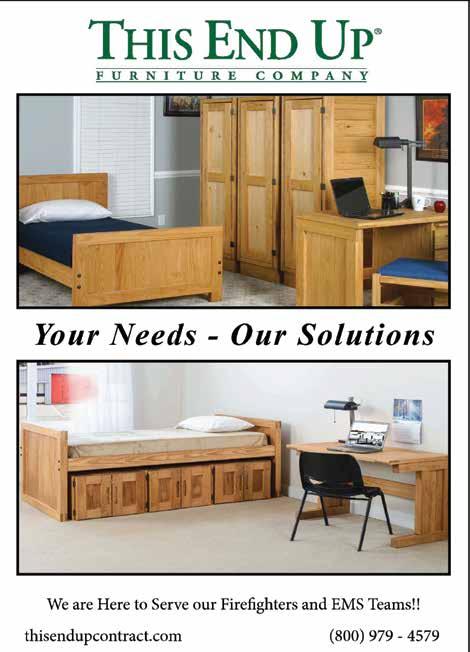
8 minute read
Recent Construction Prices for Fire/Rescue Stations
Ken Newell, AIA, LEED AP BD+C
Every so often, I look back with amazement at where the construction costs of Fire/Rescue facilities have been, and where they are going. I realize that I’m getting old, but I’m reminded of just how old I’m getting when I look back at the construction cost of the fire stations our firm has designed in the 1970s. At that time, you could build a quality station…we’re not talking pole barn…for $50+ per square foot. I’d love to reminisce and trace the five-decade history of how those costs have changed, but it suffices to say quality stations cost a little more than that today!
Advertisement
In the “good ole days” you could count on consistent construction cost inflation of 3-5% per year? If you were developing a Capital Improvement Plan for a new station three years from now you could just take today’s construction costs, increase them by 3-5% per year for three years, and know that what you had budgeted would likely be fine. Not anymore!
We all understand that the construction industry has always experienced price spikes (and rarely decreases) mostly due to some sort of material or labor force issue. Many departments, who one year ago, budgeted more than enough funds to build, are now this year forced to scale back their plans
Our design firm typically receives construction bids on multiple projects each month, most of which are fire or other public safety facilities. The construction cost tracking provided herein is based solely on pricing received on Fire/Rescue stations that we have been associated with for over five decades. If you have intentions to build or renovate soon, please take a moment to consider what is happening in the construction world and what you can do about it to protect the viability of your upcoming project.




TWENTY PLUS-YEAR HISTORY OF STATION PRICES
Looking back over the past couple of decades, we find that there have always been periods of higher-thannormal construction price increases, usually resulting from identifiable causes. From 1999 until 2006 some events caused incredible construction cost increases. The war efforts following the 911 attacks, the tremendous growth of the Chinese economy, and natural disasters such as Hurricane Katrina were just some of the events that commonly yielded 15-30% increases per year in construction inflation rates.
The rarity of seeing construction prices drop was experienced during labor and material shortages when the economy turned around.
By 2013, the pent-up demand resulting from 4-5 years of not moving forward with construction resulted in a construction boom




2008 and 2009, during the depths of the Great Recession. In 2008 construction prices decreased by approximately 12%. Then in 2009, they dropped another 16%. The “luck of the draw” projects that were “shovel-ready” and funded during this time became the beneficiaries of the lowest construction bids in years. Unfortunately, approximately onethird of all building contractors, subcontractors, and material suppliers went out of business during this period, setting us up for which drove 2014 construction prices up between 20-23%. Following a modest price increase of 3% in 2015, the period from 2016 to 2019 saw higher than normal inflation and escalation increases, and unusual volatility in bidding, due to several hurricanes and wildfires, higher construction demands, international tariffs or the threat of tariffs, and a general building boom due to a strong economy.
Then came 2020, the volatile construction price period that we still find ourselves in today. These past couple of years have proven to be a perfect storm of multiple events and issues that have driven construction cost increases higher than seen in a very long time. The Pandemic shut down labor pools and entire economic sectors for long and continuous periods. The Supply Chain disruptions continue to delay or cancel the availability of construction materials, and lengthen a project’s construction period, adding costs for the foreseeable future. Both Labor and Material Shortages grow as the aforementioned and following problems abound. Believing that construction prices will not likely moderate soon, project owners are pushing their projects forward, thus creating even Higher Demand. Fuel prices have skyrocketed due to current policy decisions. While these issues and more place tremendous pressures on actual construction costs, other issues, such as higher interest rates, are increasing other project cost categories.
WHAT TO EXPECT FOR THE NEXT YEAR?
Likely, more of the same. At least that is what most in the design and construction industry guess. The problems that have created the current construction climate and challenges didn’t happen overnight, and they’re not likely to be resolved overnight.
Stewart-Cooper-Newell Architects
fire stations. ems. training facilities.
www.fire-station.com 704.865.6311 Raleigh, NC Fire Station No. 6
What can you do to avoid the greatest adverse impact on a construction project during these volatile times? Here are a few ideas that may help: 1. Consider a scope change in what you need to build now. If portions of your facility are to accommodate future growth, design the building so that those portions can be easily built additions in the future. Maybe you can “shell-in” portions of the building and “upfit” them later. 2. Investigate whether a construction type change can fit your needs and program.
Steel, masonry, wood, precast concrete, pre-engineered metal, etc. all have advantages, limitations, and delivery availabilities. Knowing which of these construction types will fit your program needs and budget is critical. 3. Set realistic construction budgets. Projecting construction costs several months early has never been more difficult than today.
Protect yourself by using highcost estimates. Very few people will be upset with you when the project comes in under budget.
If your department is like most others, it won’t be difficult to find something productive to do with left-over funding. 4. Continually educate those that will provide your building funds.
Whether it is a City Council,
Town or County Manager,
Department Board, etc., you should regularly update them on the current bidding climate.
Each time your designer or builder provides an updated estimate make sure to pass the information along. Give them reference articles that describe the issue. Don’t let the decisionmakers get to Bid Day without knowing what to expect.
5. Make wise, informed decisions, but move quickly. Construction inflation rates can eat away at your project scope in a very short period. For example, assume you have just the capital today for the project you need, but you are not ready to receive construction bids for twelve more months. If there is a ten percent construction escalation by bid day, you will either get your hands on ten percent more money or reduce the building size/scope by ten percent.
6. Carefully consider your project delivery method. In other words, will you utilize:
• Design-Bid-Build: The traditional approach where you hire the designer to go through the complete design process, then receive bids from general contractors, one of which you will hire separately to build your project.

• Design-Build: An approach where you hire only the general contractor, who hires a designer that works for him.
• Construction Manager at
Risk (CMAR): An approach where you hire the designer based on qualifications, and you hire the general contractor
CMAR based on qualifications.
Because the CMAR is brought on board early during the design phase, they provide input on the best value systems, materials, and finishes available, plus they provide a Guaranteed
Maximum Price early so that you know what to expect earlier than traditional bidding. • We have found that the industry is trending towards the
CMAR method, particularly during these times of volatile construction climates. Many project owners feel that they have greater control of the design and construction quality, along with price, utilizing this method. 7. Finally, design wisely. Make sure you and especially your design team know how to maximize your program needs in the minimum space. Every wasted square foot will cost you more money today than it did last month. It is more important than ever to select designers who know the ins and outs of station design.
Don’t let the ups and downs of the construction climate stifle your plans. Just plan wisely, do your homework, and stay informed!
Ken Newell is a Principal and Partner with Stewart-Cooper-Newell Architects. Since 1988, he has been directly involved in over 300 of the firm’s 425+ Fire/EMS and Public Safety projects. Newell has earned a national reputation for the programming and design of public safety facilities that are functional, practical, and budget-conscious. He has also consulted other architects on the planning and design of over 125 public safety projects spanning 27 states. Because of his extensive experience in Public Safety design, he has been invited to speak at many state, regional, and national Public Safety conferences since 2000.










